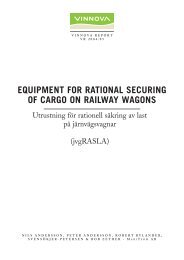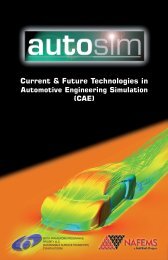WP3: Rail Passenger Transport - TOSCA Project
WP3: Rail Passenger Transport - TOSCA Project
WP3: Rail Passenger Transport - TOSCA Project
Create successful ePaper yourself
Turn your PDF publications into a flip-book with our unique Google optimized e-Paper software.
speeds in the range of 220–250 km/h are expected. This may an underestimation, as some<br />
networks already today partly run this class of trains at top speeds in the range 200–230 km/h<br />
(Germany, France, Spain, Sweden, UK, etc).<br />
For ‘High-speed trains’ the commercial top speed in Europe (2009) is 320 km/h, while a more<br />
common operating top speed is 300 km/h that is also defined as the reference case in Table 2-1.<br />
In China trains for 380 km/h are already on order, although it is uncertain when and to what<br />
extent such speeds will be utilized commercially in the near future. European high-speed trains<br />
are assumed to have a typical top speed around 370 km/h in 2050, corresponding to an average<br />
annual increase of 0.5 % per year. Thus, the historical trend of about 0.9 % long-term annual<br />
speed increase is assumed to be broken. This is due to assumed difficulties to abate noise<br />
emissions as well as increased cost for infrastructure investment and maintenance.<br />
In local train services however, with shorter stopping distances, the top speed will increase at a<br />
slower rate, estimated to be 0.3–0.4 % per year. In diesel operations the average speed is<br />
assumed not to increase at all, as the more competitive routes are assumed to be electrified,<br />
although exceptions may occur.<br />
It should be pointed out that the average speed, including stops and other delays, will usually<br />
increase at a lower rate than the top speed. This will be shown in Table 5-2 of Section 5.2.<br />
Load factor - seat occupancy<br />
Many railway operations have a comparatively low average seat occupancy rate or load factor<br />
(30–50 %) if compared for example with airlines. High-speed trains however, usually have an<br />
average load factor of 60–75 %, which is more comparable with domestic airlines. Too many<br />
empty seats are, of course, not desirable neither from an economic nor from a specific energy<br />
point of view. With deregulation, increasing competition and more business-oriented railway<br />
companies the load factor would improve, by flexible fares and by other means. This is to a<br />
large extent what has happened to the airlines in Europe and North America after deregulation.<br />
Increased load factor is not a “technology”, its future potential is hard to quantify with<br />
precision and is therefore not considered in the following analysis. This factor could be an<br />
option of additional improvement in energy and GHG emissions per passenger-km.<br />
3.5 Technology scenarios to be further considered and investigated<br />
Some of the technologies described in Section 3.3 are very promising for the future, as they<br />
offer large energy and GHG savings in at least some types of services and also experience high<br />
possible market penetration, i.e. in several types of rail services with considerable total market<br />
share. These promising technologies constitute five scenarios (1–5) to be further considered<br />
and investigated in this study.<br />
1 PA. Low-drag<br />
2 PB. Low-mass<br />
3 PC. Energy recovery<br />
4 PD. Space efficiency<br />
5 PF. Eco-driving<br />
The following combined scenarios are also studied:<br />
6 Pcomb electric: PA + PB + PC + PD + PF + Incremental<br />
7 Pcomb HS electric: As (6) + Higher Speed<br />
8 Pcomb as (7) + low GHG electric power<br />
9 Pcomb diesel: PA + PB + PC + PD + PF + Incremental<br />
Deliverable D4 – <strong>WP3</strong> passenger 13
















